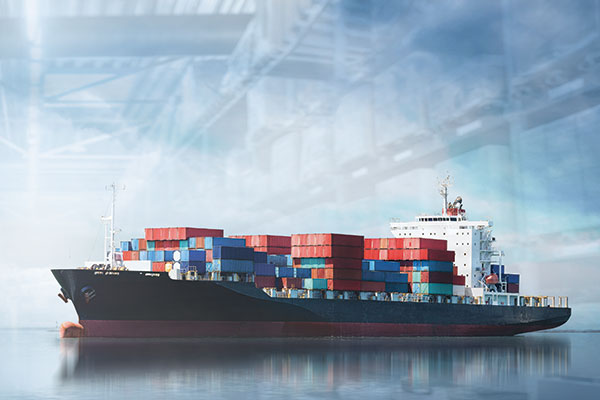Slow import growth and tough annual comparisons are key themes of Port Tracker report
United States-bound import volumes are pegged to see gains through the summer months, albeit at below levels seen during the pandemic, according to the new edition of the Port Tracker report, which was issued today by the National Retail Federation (NRF) and maritime consultancy Hackett Associates.
The ports surveyed in the report include: Los Angeles/Long Beach; Oakland; Tacoma; Seattle; Houston; New York/New Jersey; Hampton Roads; Charleston, and Savannah; Miami; Jacksonville; and Fort Lauderdale, Fla.-based Port Everglades.
Authors of the report explained that cargo import numbers do not correlate directly with retail sales or employment because they count only the number of cargo containers brought into the country, not the value of the merchandise inside them, adding that the amount of merchandise imported provides a rough barometer of retailers’ expectations.
“Last spring and summer were the busiest ever as consumers spent freely and retailers brought in merchandise to meet demand,” NRF Vice President for Supply Chain and Customs Policy Jonathan Gold said in a statement. “This year won’t repeat that, but the numbers we’re expecting would have been considered normal before the pandemic. The priority at the moment is resolving labor negotiations at the West Coast ports and avoiding any self-inflicted supply chain challenges on top of those we’ve faced the past three years.”
The report highlighted how the NRF recently sent a letter, with more than 200 national, state, and local trade associations to President Biden, calling on the White House to take action, regarding the still-unresolved West Coast port labor negotiations between the International Longshore and Warehouse Union (ILWU) and the Pacific Maritime Association (PMA), with the current contact between the parties having expired on July 1, 2022. It also noted that while West Coast port workers remain on the job, a large number of shippers have relocated cargo to other ports in order to avoid any type of potential disruption.
For February, the most recent month for which data is available, Port Tracker noted that import volumes, for the ports covered in the report, came in at 1.55 million TEU (Twenty-Foot Equivalent Units), for a 14.4% decrease compared to February and a 26.8% annual decrease. The report observed that February is historically the slowest month of the year, with February 2023 marking the lowest volume tally for the month going back to May 2020’s 1.53 million TEU, when several Asian-based factories and U.S.-based stores were closed because of the pandemic. March data was not publicly available, but the report projected it to come in at 1.68 million TEU, for a 28.2% annual decrease.
Port Tracker issued projections for the subsequent months, including:
- April, at 1.86 million TEU, for an 18% annual decrease;
- May, at 1.91 million TEU, for an 20.1% annual decrease;
- June at 1.99 million TEU, for an 11.8% annual decrease
- July, at 2.1 million TEU, for a 3.9% annual decrease (which would mark the first time imports are estimated to be that high going back to October 2022); and
- August, at 2.13 million TEU, for a 5.9% annual decrease
The projected steep annual declines are were attributed to what the report called unusually high volumes in 2022, the report noted. And it added that a 20-month stretch of monthly volumes topping the 2 million TEU mark, which commenced in 2021 and included a single-month high of 2.4 million TEU in May 2022 ran through November 2022. What’s more, it stated that in pre-pandemic 2019, the monthly average for imports was 1.8 million TEU.
For the first half of calendar year 2023, Port Tracker expects total import volume to come in at 10.8 million TEU, which would represent a 20.2% annual decline.
Hackett Associates Founder Ben Hackett wrote in the report that compared to last year the flow of containers on the West Coast continues to decline, in tandem with demand, as carriers increasingly drop service to Los Angeles-area ports but stretch voyages to include other ports of call to help absorb excess capacity.
“Meanwhile, freight rates have been impacted by the fall in demand, but new ships are starting to show up and more have been ordered—a sign that carriers expect demand will improve by the time the new vessels are delivered,” he wrote. “The capacity of ships on order is equal to nearly 30 percent of the existing container fleet.”
And he also observed that the economic impact of housing costs and the drawdown of built-up retail inventories of consumable goods have been prominent factors in the declining level of imports.
“But housing is turning around inventories are on the rebound, suggesting that our projection of growth in the second half of the year remains solid,” he noted.
Article Topics
National Retail Federation News & Resources
U.S.-bound import growth track remains promising, notes Port Tracker report NRF 2024 retail sales forecast calls for growth National Retail Federation 2024 retail sales forecast calls for growth February retail sales see gains, reports Commerce and NRF Port Tracker report presents a positive outlook for first half U.S.-bound import numbers Retailers Forecast Import Growth Despite Red Sea Delays Port Tracker report points to import volume growth over the first half of 2024 More National Retail FederationLatest in Supply Chain
Ranking the World’s 10 Biggest Supply Chains The Top 10 Risks Facing Supply Chain Professionals Walmart’s Latest Service: Ultra Late-Night Delivery DHL Supply Chain Appoints New CEO Amidst Leadership Changes Dollar Tree’s Oklahoma Distribution Center Decimated by Tornado City of Baltimore Files Lawsuit to Recoup Money for Collapsed Bridge The Era of Self-Driving Tractor-Trailers Set to Begin More Supply ChainAbout the Author











